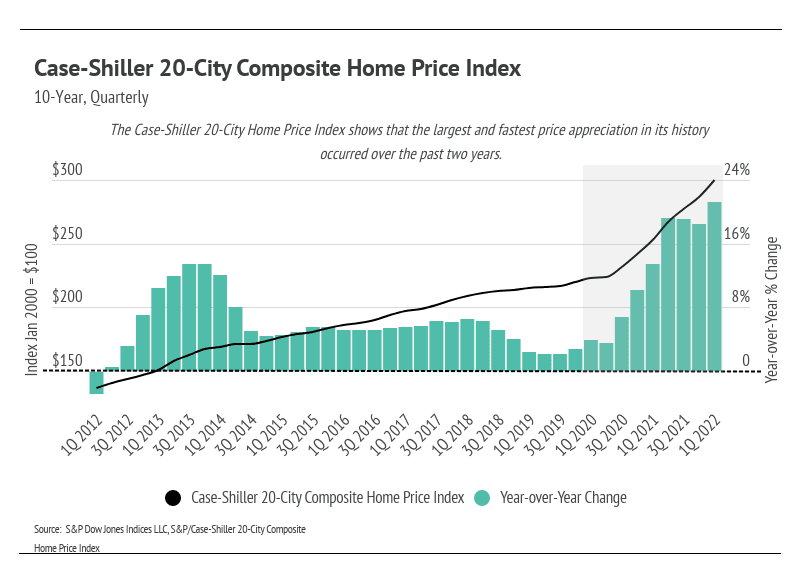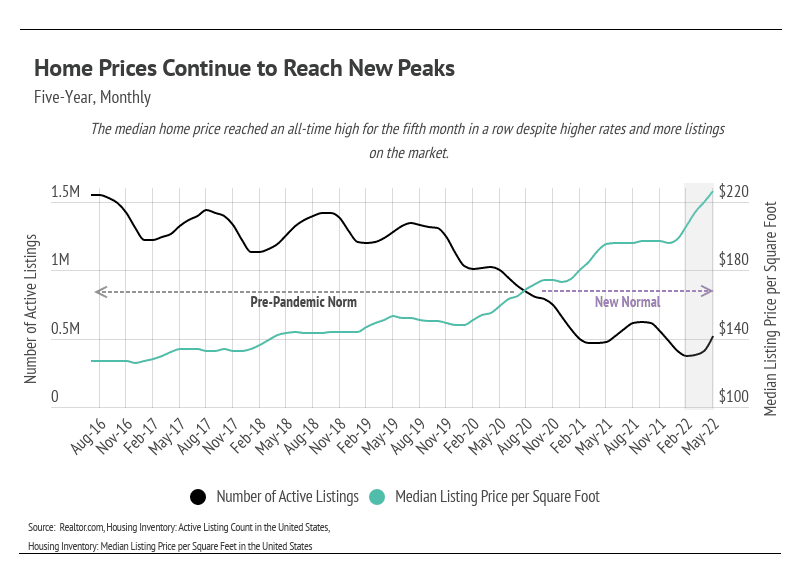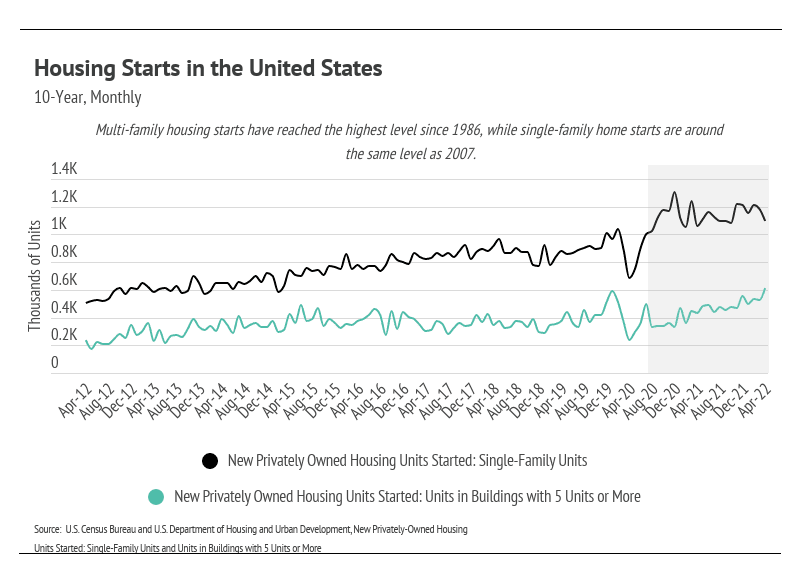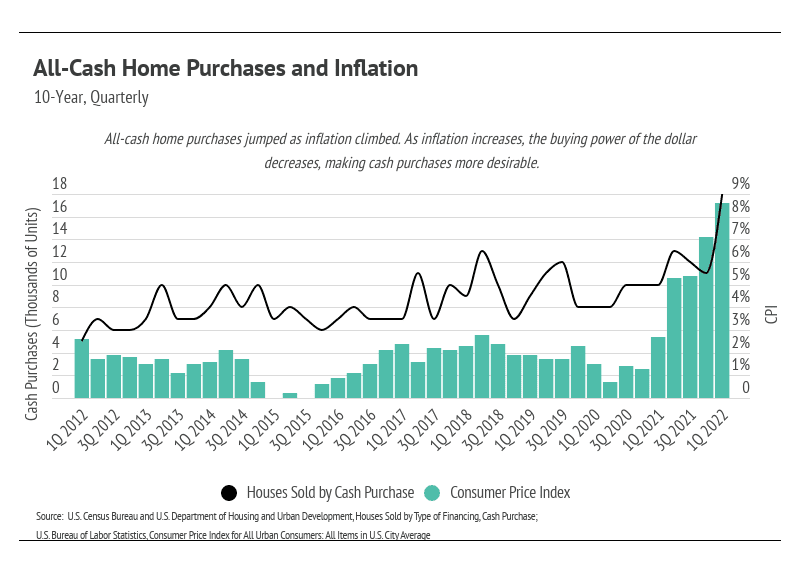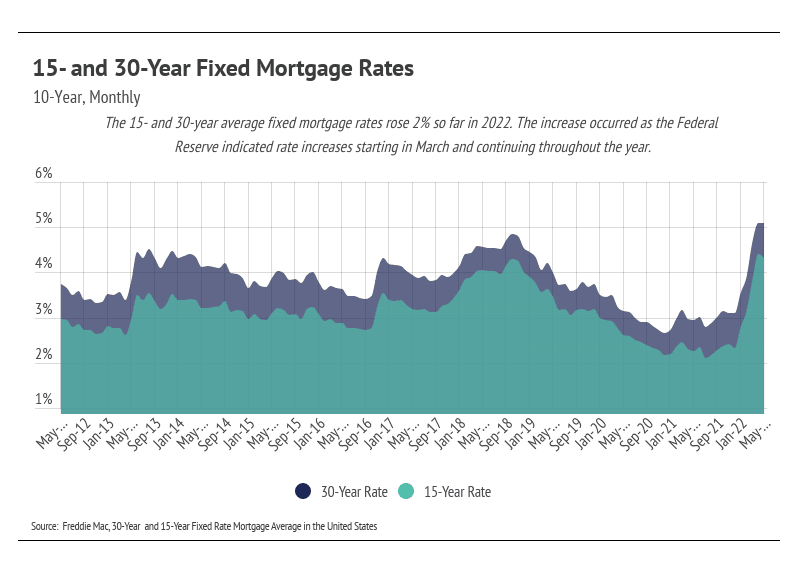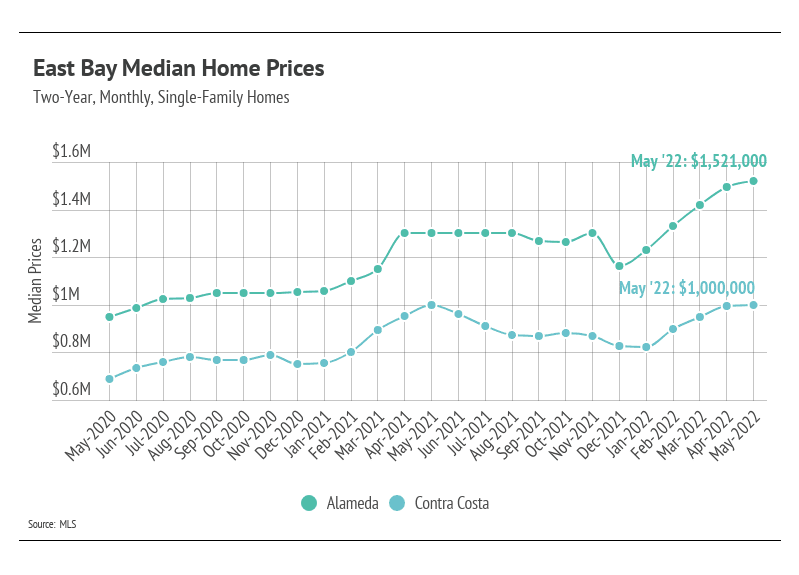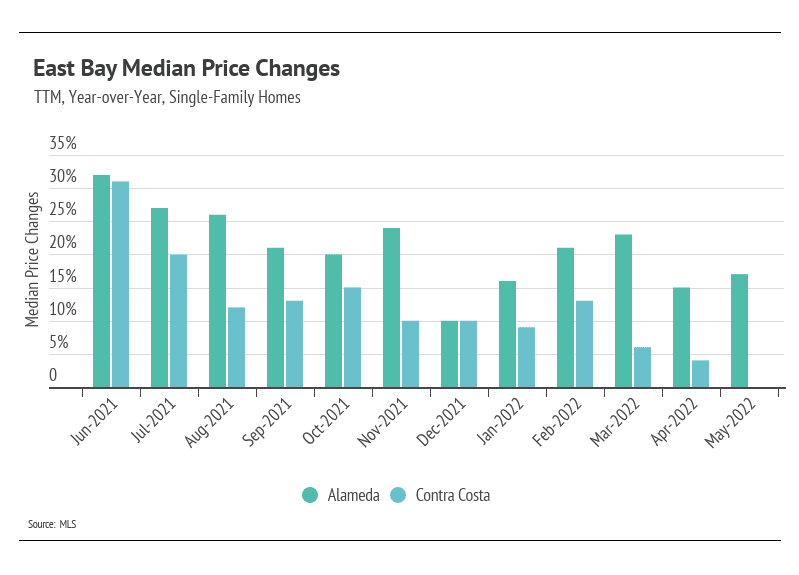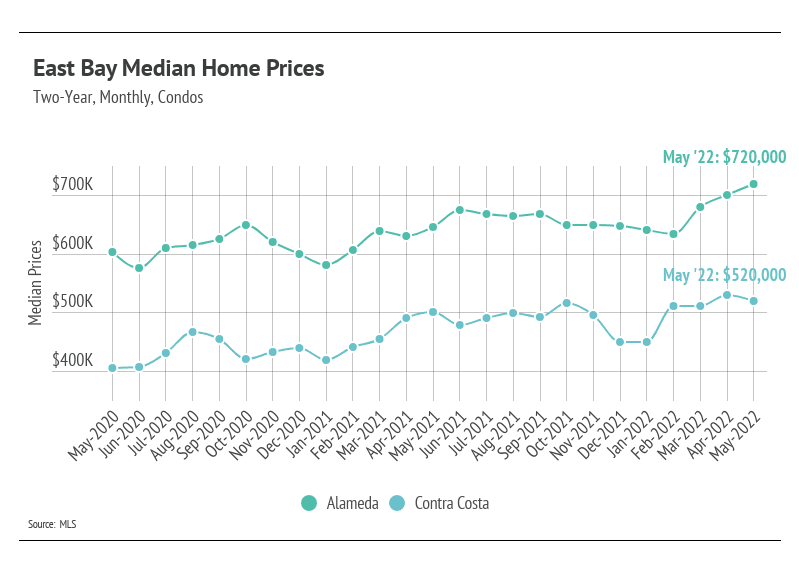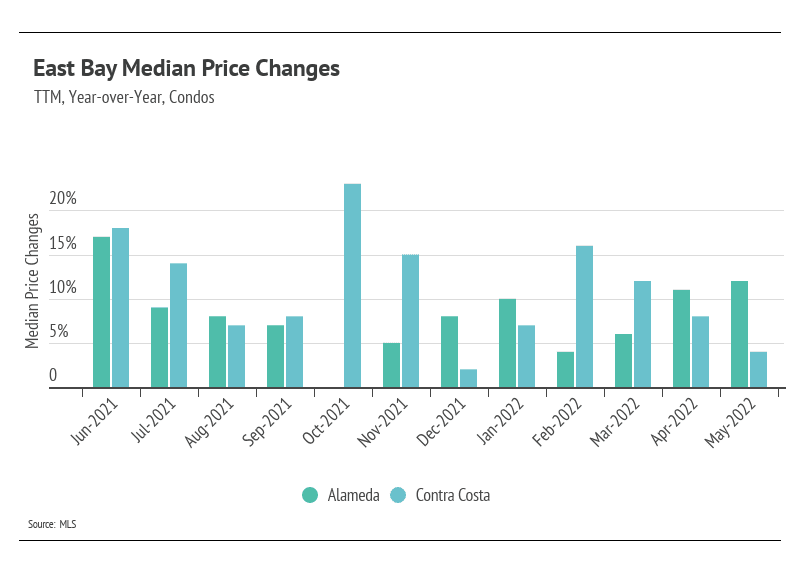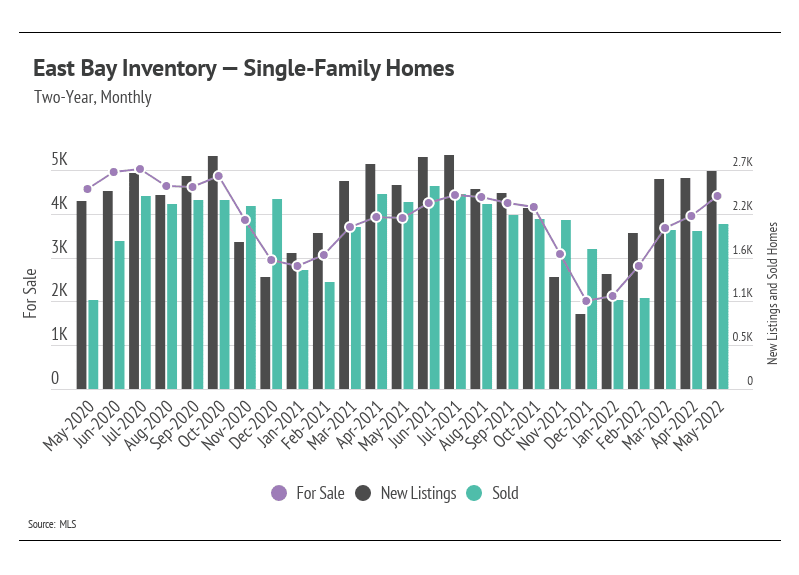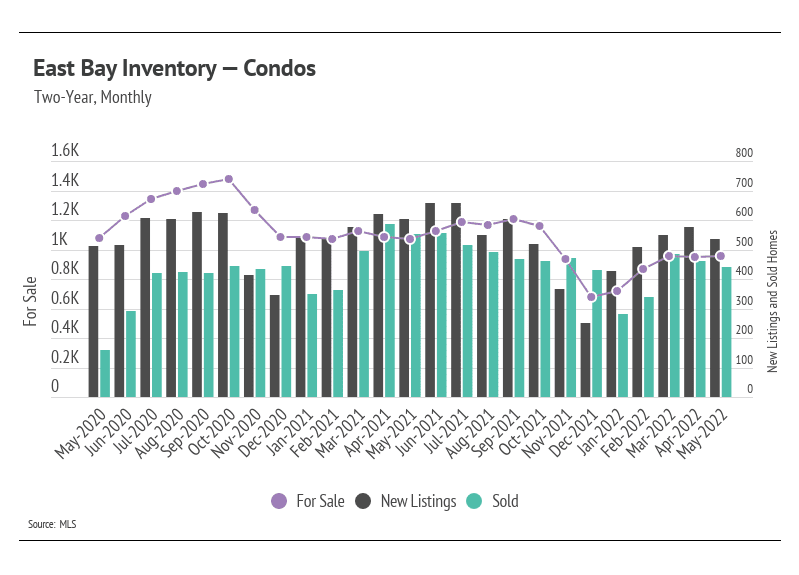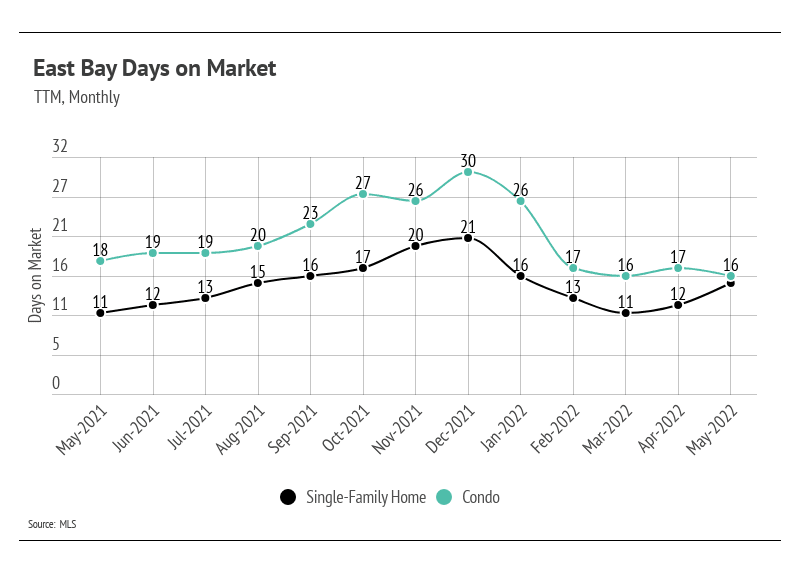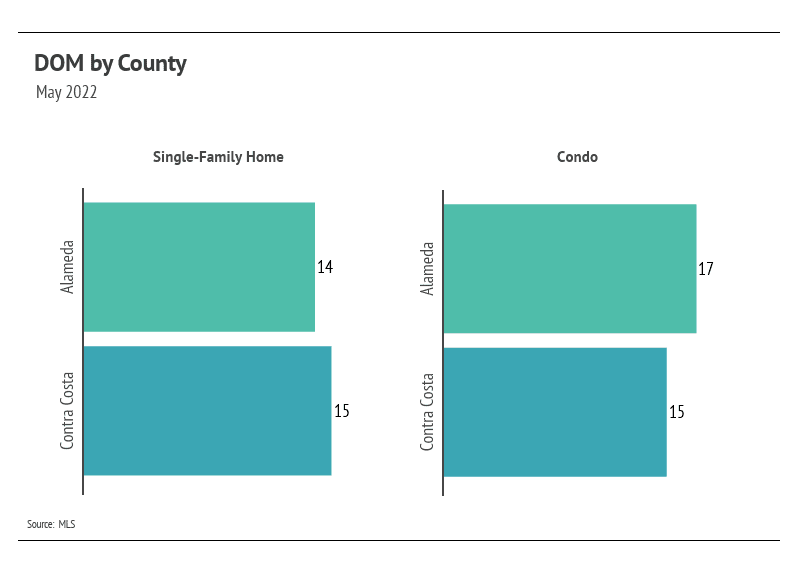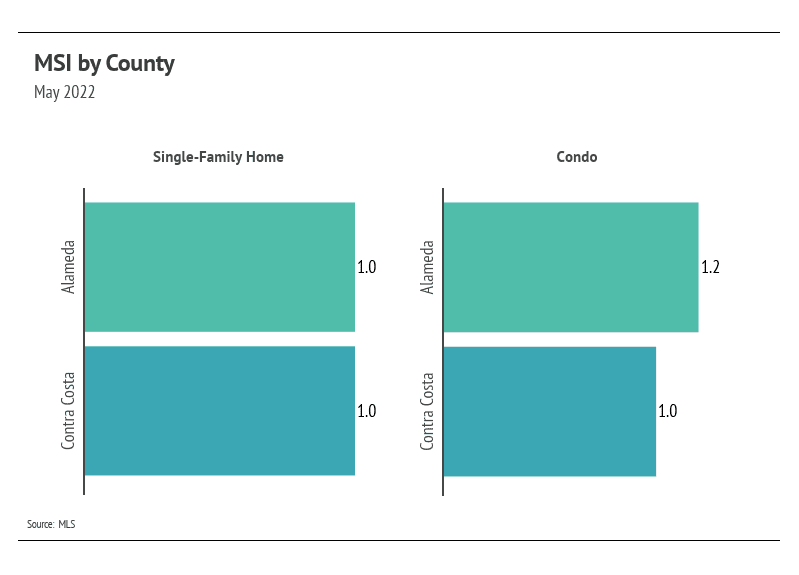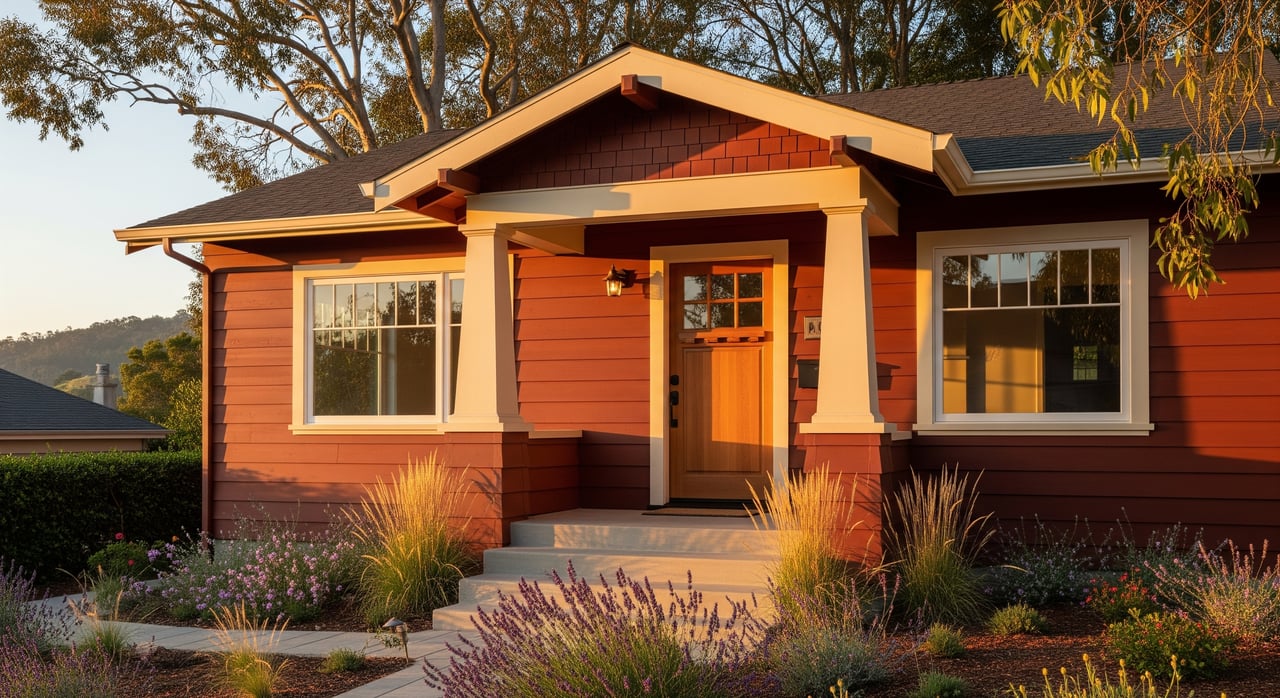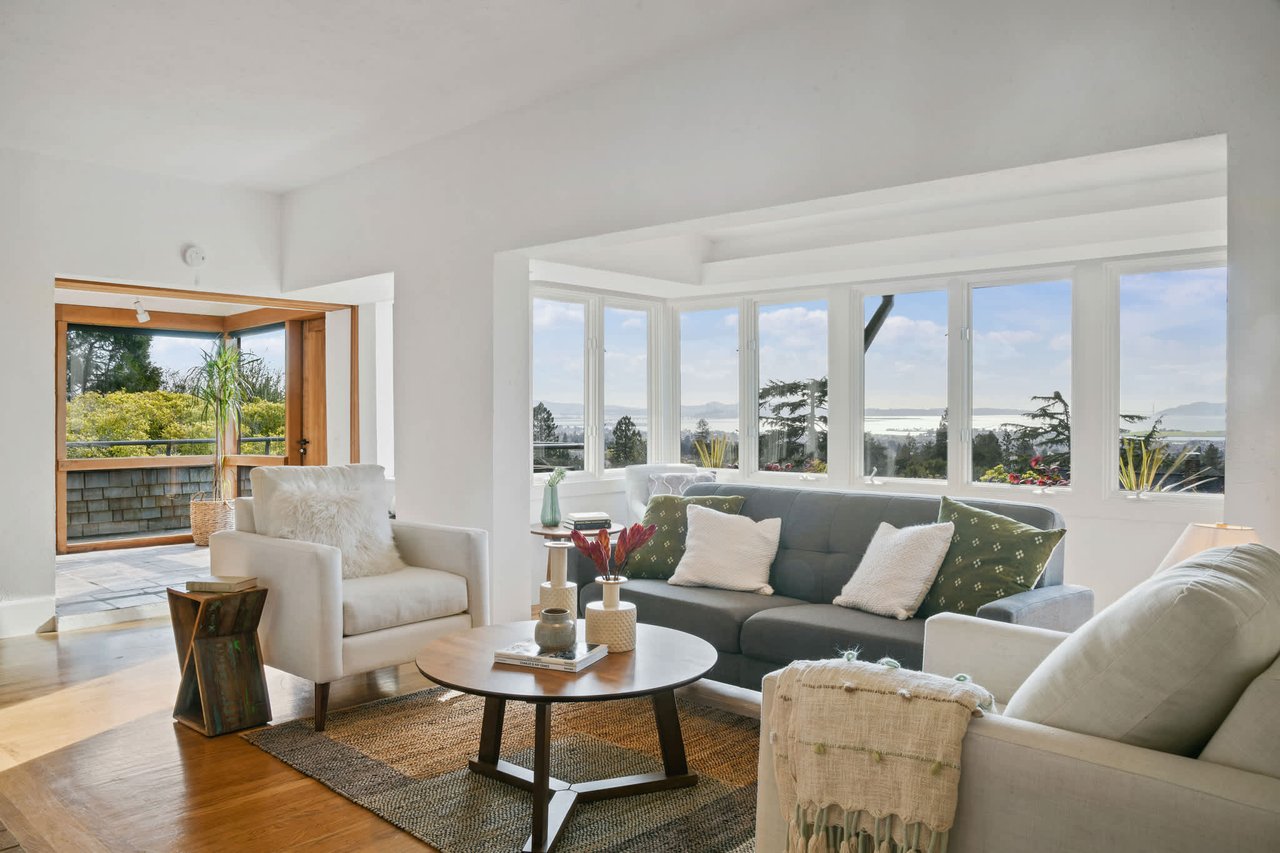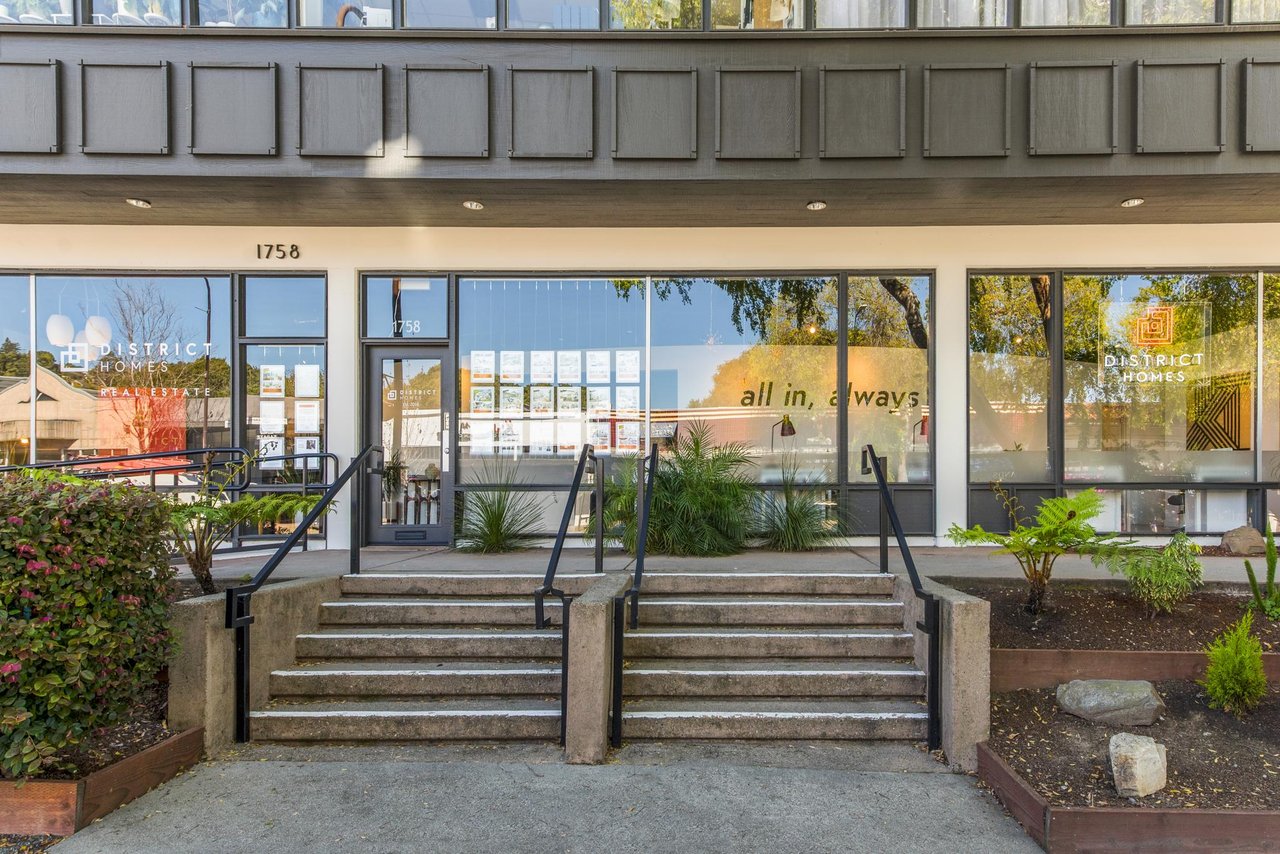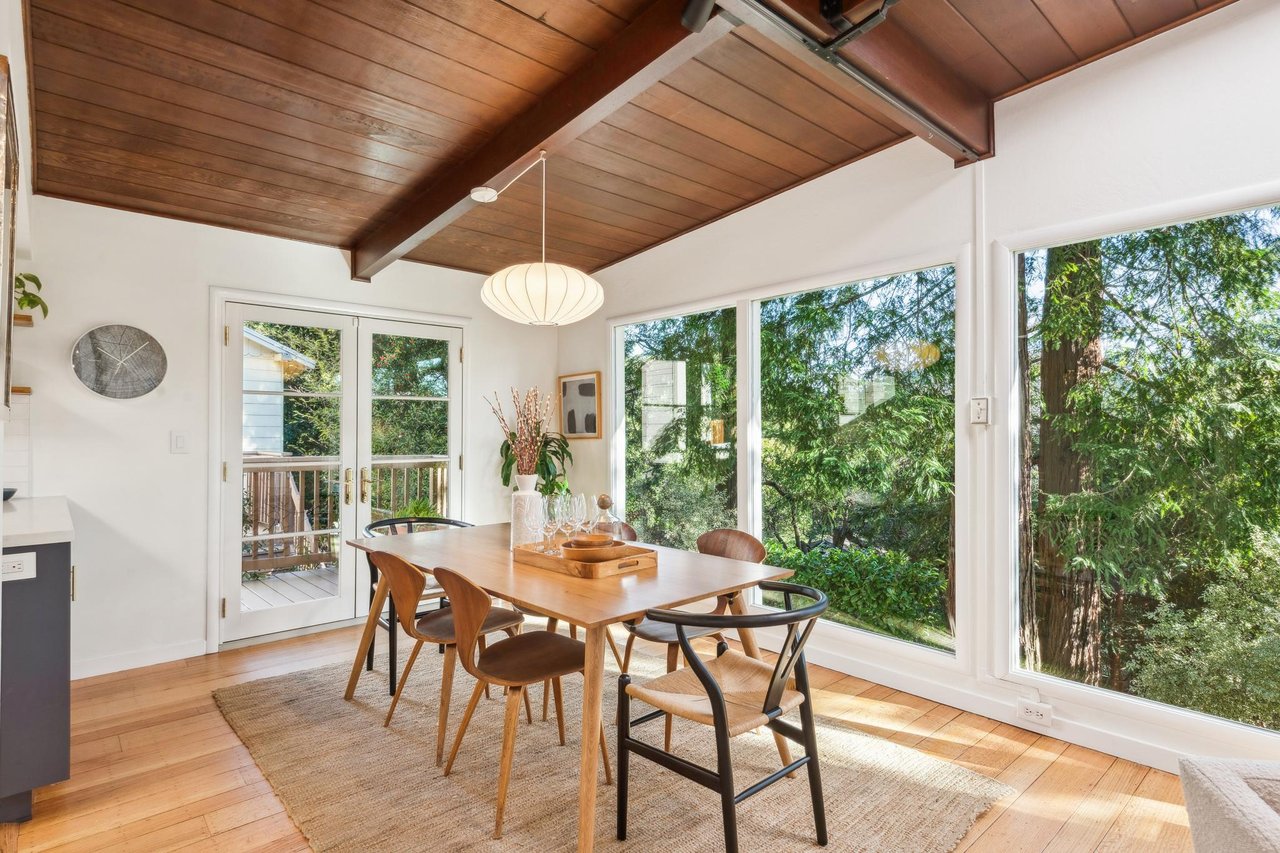The Big Story
Mortgage rate increases slow; housing stays hot
Quick Take:
- Record high home prices continue in the face of rising mortgage rates and record inflation. All-cash sales jump because buyers want to avoid higher rates and maximize purchasing power.
- The housing market is roughly four to five years behind on building new homes, which means the supply issue isn’t ending soon.
- Although more homes are coming to market, and demand is softening marginally as mortgage rates rise, prices are still moving higher as buyers compete over the new inventory.
Note: You can find the charts and graphs for the Big Story at the end of the following section.
Prices continue to rise as mortgage rates hit 13-year highs.
It’s become hard to accurately describe the state of the housing market in the face of rising rates, historically low supply, and high but softening demand. Real estate professionals often say the market is cooling to indicate a turn from a sellers’ to a buyers’ market, but that feels like an overstatement. Additionally, some recent articles were published with titles like “Cracks in the Housing Market,” which also may make the reader erroneously think we are headed into a major correction. After much deliberation, we decided to define market hotness with a pepper analogy. The current market is going from the hottest pepper in the world, the Carolina Reaper, to the second hottest, the Trinidad Moruga Scorpion. Yes, the market is technically becoming less hot, but it’s still about as hot as it gets. Ultimately, we believe we are headed toward a steadier state of growth rather than a significant home price reversal. Home prices will still fluctuate month-to-month, which is normal, but they will generally trend higher at a slower pace. A slower growth rate is a healthy growth rate.
In May, home prices increased around 16% year-over-year, which means that prices would double every 4.5 years if that trend were to continue. That kind of rapid growth is simply unsustainable and would eventually lead to a major market collapse. Based on what happened as a result of the 2006 housing bubble, we know that mass wealth destruction is not the path we want to take. The Federal Reserve (the Fed) is actively raising rates to bring down the growth rate by making borrowing more expensive, thereby lowering demand. Luckily, we are starting to see inflation respond to the Fed’s monetary policy, although it is still near a 40-year high.
In 2022, mortgage rates have moved about 2% higher for 30- and 15-year fixed mortgages, reaching 5.09% for the average 30-year fixed-rate mortgage and 4.32% for the average 15-year fixed-rate mortgage as of June 2, 2022. Every 1% rate increase raises the monthly mortgage payment significantly — by about 13%. In this environment of rising rates and rising inflation, all-cash purchases become more attractive because financing is more expensive and money is worth less over time. In the first quarter of 2022, all-cash purchases increased, reaching the highest levels since 1988. Economists now estimate that the average 30-year mortgage rate could climb above 6% in 2022. Because the Fed indicated the path of rate hikes for the rest of the year, we expect that mortgage rates will, at most, reach around 7% this year for prime borrowers.
If it feels like you missed a unique opportunity to finance a home at under 5%, we are sorry to say that you did. However, you are in good company and can still take advantage of low rates. While it can feel like rates are high when they’ve risen from the all-time low of only a few months earlier, a rate of 5% is still historically low. Since 1971 (the start of the data set), we’ve had 2,671 weekly 30-year mortgage data points, only 24% of which reflected rates below 5%.
The market has remained so hot because of supply — or lack thereof. In May, the housing supply ticked up ever so slightly but is still 49% lower than the number of homes on the market in May 2020. We are entering what is traditionally the hottest time of year for the housing market with a record low supply of homes. Through May 2022, which had the lowest inventory on record, home prices increased 15%. The chief economist at Realtor.com, Danielle Hale, explains that the market is about 5.8 million single-family homes short, which means we’re four to five years behind in building new homes. Although single-family housing starts — homes that have begun construction — have slowed recently, multi-unit housing (5+ units) starts have reached their highest numbers since 1986.
If you are considering buying a home, there aren’t many reasons to wait. Home prices and rates are still rising. The low but rising supply continues to make the market extremely competitive. We are starting to see some softening in demand, but not nearly enough to balance the supply side of the market.
Big Story Data
The Local Lowdown
Quick Take:
- Home prices in the East Bay reached record highs in May as more homes entered the market.
- The second quarter of 2022 will indicate whether the market is moving toward or away from normalization. May data show that the number of single-family homes for sale rose while condo inventory declined, which indicates that inventory will likely follow the normal seasonal trend, but at a depressed rate.
- Despite some mild softening of demand as rates increase, the low but rising housing supply will continue to drive prices up, as buyers are more easily matched with the right home.
Note: You can find the charts/graphs for the Local Lowdown at the end of this section.
Home prices continue to rise as new listings meet high demand
East Bay median single-family home prices reached all-time highs in Alameda and Contra Costa in May. Condo prices were slightly more mixed, with Alameda prices reaching a new peak while Contra Costa prices declined slightly from the April high. Rising rates haven’t brought down home demand so far, and in a rising rate environment, buyers are better off locking in an interest rate sooner rather than later. Since the start of 2022, the average 30-year mortgage rate has increased 2%, which equates to a 27% increase in monthly mortgage payments. Yet prices keep moving higher.
One reason that home prices continue to rise is that buying a home is not only a financial process, but also an emotional one. Over the past two years, our homes have become such a large part of our lives, with many of us moving to permanently remote or hybrid work. As more homes come to the market, as is typical in the first half of the year, buyers are more likely to find the home that’s right for them in what’s been an incredibly competitive market. Even with increases in mortgage rates (which, again, are still historically low), it’s reasonable to pay more for the well-being that comes with buying the right home. For most of us, our home is our largest asset and store of wealth, so treating it as such makes sense.
Low but rising inventory, according to the seasonal norm
The East Bay’s housing inventory increased in May, which serves as an early indicator that home supply may follow historically typical seasonal trends, though at a depressed level. The high demand and lack of new listings over the past year brought single-family home and condo supplies to record lows as we entered 2022. Although the first quarter of 2022 had one of the lowest inventories on record, we were pleased to see that inventory increased, a trend that usually holds until mid-summer. With May inventory continuing to rise, the next two to three months will likely show us peak inventory levels for 2022.
Even though inventory is low, sales remain relatively high. Sellers can expect multiple offers, and buyers should come with competitive offers.
Months of Supply Inventory further indicates high demand and low supply
Homes are selling extremely fast. Buyers must put in competitive offers, which, on average, are 13% above the list price for single-family homes and 7% above list for condos.
Months of Supply Inventory (MSI) quantifies the supply/demand relationship by measuring how many months it would take for all current homes listed on the market to sell at the current rate of sales. The average MSI is three months in California, which indicates a balanced market. An MSI lower than three indicates that there are more buyers than sellers on the market (meaning it’s a sellers’ market), while a higher MSI indicates there are more sellers than buyers (meaning it’s a buyers’ market). Currently, single-family home and condo MSIs are exceptionally low, indicating a strong sellers’ market.
Local Lowdown Data



